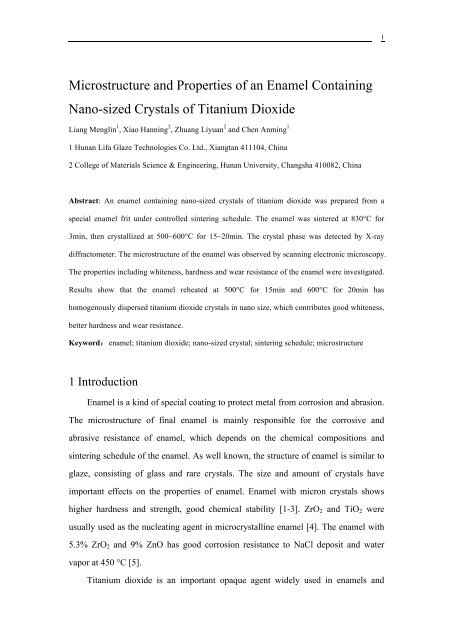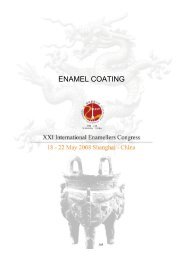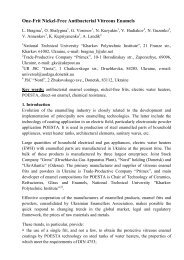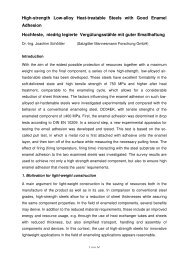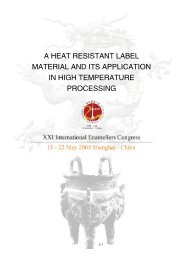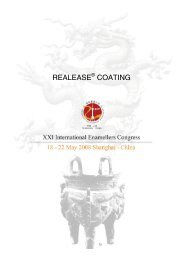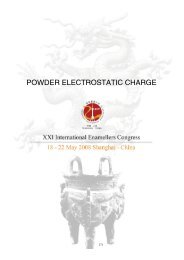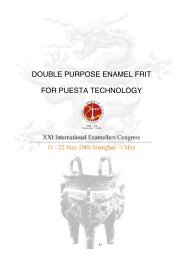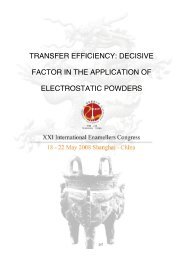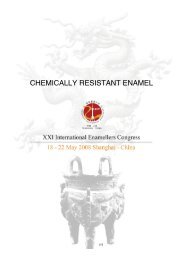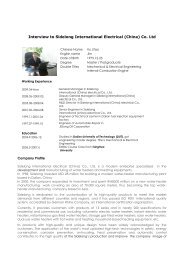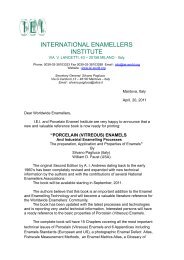Microstructure and Properties of an Enamel Containing Nano-sized ...
Microstructure and Properties of an Enamel Containing Nano-sized ...
Microstructure and Properties of an Enamel Containing Nano-sized ...
Create successful ePaper yourself
Turn your PDF publications into a flip-book with our unique Google optimized e-Paper software.
1<br />
<strong>Microstructure</strong> <strong><strong>an</strong>d</strong> <strong>Properties</strong> <strong>of</strong> <strong>an</strong> <strong>Enamel</strong> <strong>Containing</strong><br />
N<strong>an</strong>o-<strong>sized</strong> Crystals <strong>of</strong> Tit<strong>an</strong>ium Dioxide<br />
Li<strong>an</strong>g Menglin 1 , Xiao H<strong>an</strong>ning 2 , Zhu<strong>an</strong>g Liyu<strong>an</strong> 2 <strong><strong>an</strong>d</strong> Chen Anming 1<br />
1 Hun<strong>an</strong> Lifa Glaze Technologies Co. Ltd., Xi<strong>an</strong>gt<strong>an</strong> 411104, China<br />
2 College <strong>of</strong> Materials Science & Engineering, Hun<strong>an</strong> University, Ch<strong>an</strong>gsha 410082, China<br />
Abstract: An enamel containing n<strong>an</strong>o-<strong>sized</strong> crystals <strong>of</strong> tit<strong>an</strong>ium dioxide was prepared from a<br />
special enamel frit under controlled sintering schedule. The enamel was sintered at 830°C for<br />
3min, then crystallized at 500~600°C for 15~20min. The crystal phase was detected by X-ray<br />
diffractometer. The microstructure <strong>of</strong> the enamel was observed by sc<strong>an</strong>ning electronic microscopy.<br />
The properties including whiteness, hardness <strong><strong>an</strong>d</strong> wear resist<strong>an</strong>ce <strong>of</strong> the enamel were investigated.<br />
Results show that the enamel reheated at 500°C for 15min <strong><strong>an</strong>d</strong> 600°C for 20min has<br />
homogenously dispersed tit<strong>an</strong>ium dioxide crystals in n<strong>an</strong>o size, which contributes good whiteness,<br />
better hardness <strong><strong>an</strong>d</strong> wear resist<strong>an</strong>ce.<br />
Keyword:enamel; tit<strong>an</strong>ium dioxide; n<strong>an</strong>o-<strong>sized</strong> crystal; sintering schedule; microstructure<br />
1 Introduction<br />
<strong>Enamel</strong> is a kind <strong>of</strong> special coating to protect metal from corrosion <strong><strong>an</strong>d</strong> abrasion.<br />
The microstructure <strong>of</strong> final enamel is mainly responsible for the corrosive <strong><strong>an</strong>d</strong><br />
abrasive resist<strong>an</strong>ce <strong>of</strong> enamel, which depends on the chemical compositions <strong><strong>an</strong>d</strong><br />
sintering schedule <strong>of</strong> the enamel. As well known, the structure <strong>of</strong> enamel is similar to<br />
glaze, consisting <strong>of</strong> glass <strong><strong>an</strong>d</strong> rare crystals. The size <strong><strong>an</strong>d</strong> amount <strong>of</strong> crystals have<br />
import<strong>an</strong>t effects on the properties <strong>of</strong> enamel. <strong>Enamel</strong> with micron crystals shows<br />
higher hardness <strong><strong>an</strong>d</strong> strength, good chemical stability [1-3]. ZrO 2 <strong><strong>an</strong>d</strong> TiO 2 were<br />
usually used as the nucleating agent in microcrystalline enamel [4]. The enamel with<br />
5.3% ZrO 2 <strong><strong>an</strong>d</strong> 9% ZnO has good corrosion resist<strong>an</strong>ce to NaCl deposit <strong><strong>an</strong>d</strong> water<br />
vapor at 450 °C [5].<br />
Tit<strong>an</strong>ium dioxide is <strong>an</strong> import<strong>an</strong>t opaque agent widely used in enamels <strong><strong>an</strong>d</strong>
2<br />
paints [6,7]. However, there is little research about the precipitation <strong>of</strong> tit<strong>an</strong>ium<br />
dioxide crystals in enamels up to now. This work is to investigate the precipitation <strong>of</strong><br />
tit<strong>an</strong>ium dioxide crystals in enamels at different sintering schedule <strong><strong>an</strong>d</strong> <strong>an</strong>alysis the<br />
effect <strong>of</strong> microstructure on the properties <strong>of</strong> the enamels with n<strong>an</strong>o-<strong>sized</strong> tit<strong>an</strong>ium<br />
dioxide crystals.<br />
2 Experimental<br />
2.1 Raw materials<br />
The chemical compositions <strong>of</strong> the enamel used in this work are listed in Table 1,<br />
in which the content <strong>of</strong> tit<strong>an</strong>ium dioxide was designed in 18-20 wt%. The raw<br />
materials included quartz s<strong><strong>an</strong>d</strong>, feldspar, borax, tit<strong>an</strong>ium dioxide, fluorite <strong><strong>an</strong>d</strong><br />
phosphate. All the materials were in industrial grade <strong><strong>an</strong>d</strong> well mixed together, then<br />
melted at 1400°C in <strong>an</strong> electrical furnace to get the enamel frit.<br />
Table 1 The chemical compositions <strong>of</strong> enamel<br />
Chemical composition SiO 2 Al 2 O 3 B 2 O 3 TiO 2 Na 2 O K 2 O MgO F P 2 O 5<br />
Content(wt%) 38~41 3~5 17~19 18~20 9~11 6~8 1~2 2~3 3~4<br />
2.2 Experimental procedure<br />
The enamel frit was first ground in a ball milling to get the enamel slip. The<br />
prepared steel plate was immerged into the enamel slip, then pulled out <strong><strong>an</strong>d</strong> dried in<br />
air. The samples were sintered at 830°C in a preheated electrical furnace for 3min.<br />
(signed as 0#), then crystallized at different heating schedules (1#~3#).<br />
According to the DSC result <strong>of</strong> the enamel powder shown in Fig. 1, the glassy<br />
temperature (T g ) <strong>of</strong> the enamel is about 475°C, <strong><strong>an</strong>d</strong> the crystallization temperature (T c )<br />
is near 590°C, so the nucleation <strong><strong>an</strong>d</strong> crystallization temperature were determined as<br />
500°C <strong><strong>an</strong>d</strong> 600°C respectively.<br />
In order to investigate the relationship between the microstructure <strong><strong>an</strong>d</strong> properties<br />
<strong>of</strong> the reheated enamels, the sintered enamel (0#) were put into the furnace <strong><strong>an</strong>d</strong><br />
reheated from room temperature to elevated temperature <strong><strong>an</strong>d</strong> holding at the
3<br />
temperature for a certain time as shown in Table 2.<br />
Table 2<br />
Heat treatment schedule <strong>of</strong> the sintered enamel<br />
Sample No. Holding at 500°C (min) Holding at 600°C (min)<br />
0# 0 0<br />
1# 15 15<br />
2# 15 20<br />
3# 20 20<br />
2.3 Testing apparatus <strong><strong>an</strong>d</strong> conditions<br />
The thermal <strong>an</strong>alysis (DSC) <strong>of</strong> the enamel powder was conducted by Netzsch<br />
STA449C calorimeter at a heating rate <strong>of</strong> 10°C/min. The crystal phase was<br />
determined by Rigaku D/max 2200 X-ray diffractometer (XRD) using Cu Kα<br />
radiation at 40kV <strong><strong>an</strong>d</strong> 40mA. The microstructures <strong>of</strong> the samples were observed by<br />
sc<strong>an</strong>ning electron microscope (JEOL, JSM-6700F). The Whiteness <strong>of</strong> the samples<br />
was tested by Xinrui WSB-1 (R457 blue-ray whiteness), <strong><strong>an</strong>d</strong> the micro-hardness was<br />
conducted by MC010-HVST-1000ZA tester. Wear testing was completed in a<br />
polishing machine (UNIPOL-1202) using the sample size <strong>of</strong> 50mm×50mm.<br />
3 Results <strong><strong>an</strong>d</strong> discussion<br />
3.1 Nucleation <strong><strong>an</strong>d</strong> crystallization temperature <strong>of</strong> the enamel<br />
Fig. 1 shows the DSC curve <strong>of</strong> the enamel powder. The glassy temperature (T g )<br />
is usually to determine the nucleation temperature (T n ). The T n should be 20~30 °C<br />
higher th<strong>an</strong> the T g , so 500°C was used as the nucleation temperature in this work. The<br />
crystallization temperature (T c ) <strong>of</strong> the enamel is about 590°C, so 600°C was used as<br />
the controlling temperature for the crystallization <strong>of</strong> the enamel.
4<br />
0.5<br />
0.0<br />
-0.5<br />
475.2℃<br />
589.4℃<br />
DSC/mw/mg<br />
-1.0<br />
-1.5<br />
-2.0<br />
-2.5<br />
-3.0<br />
0 200 400 600 800<br />
temperature/℃<br />
Fig 1<br />
DSC curve <strong>of</strong> the enamel powder<br />
3.2 The crystal phase <strong><strong>an</strong>d</strong> microstructures <strong>of</strong> enamels<br />
Fig 2 shows the XRD patterns <strong>of</strong> the enamels prepared at different conditions.<br />
Only <strong>an</strong>atase (a kind <strong>of</strong> TiO 2 ) phase was detected in all <strong>of</strong> the enamels. 0# is the<br />
enamel prepared at 830°C by normal processing. There is little difference in XRD<br />
patterns among the samples prepared at different conditions. However, the<br />
microstructure <strong>of</strong> the samples is much difference as shown in Fig. 3. 0# has relative<br />
rare crystals, while 1# has the most crystals <strong><strong>an</strong>d</strong> homogenously distributed. With the<br />
increase <strong>of</strong> crystallization time, the amount <strong>of</strong> precipitated crystals becomes fewer <strong><strong>an</strong>d</strong><br />
larger.<br />
Intensity(counts)<br />
3000<br />
2500<br />
2000<br />
1500<br />
1000<br />
500<br />
)<br />
101<br />
(<br />
◇<br />
(004)<br />
◇<br />
)<br />
200<br />
(<br />
◇<br />
105<br />
211<br />
204<br />
0<br />
20 30 40 50 60 70 80<br />
2θ/<br />
)<br />
(<br />
)<br />
(<br />
◇◇<br />
。<br />
◇— Anatase<br />
)<br />
(<br />
◇<br />
◇ ◇<br />
◇<br />
Intensity(counts)<br />
3000<br />
2500<br />
2000<br />
1500<br />
1000<br />
500<br />
◇<br />
)<br />
101<br />
(<br />
(004)<br />
◇<br />
)<br />
200<br />
(<br />
◇<br />
105<br />
211<br />
204<br />
0<br />
20 30 40 50 60 70 80<br />
2θ/<br />
)<br />
(<br />
)<br />
(<br />
◇◇<br />
。<br />
◇— Anatase<br />
)<br />
(<br />
◇<br />
◇ ◇<br />
◇<br />
(a) 0# (b) 1#
5<br />
Intensity(counts)<br />
3000<br />
2500<br />
2000<br />
1500<br />
1000<br />
500<br />
)<br />
101<br />
(<br />
◇<br />
(004)<br />
◇<br />
)<br />
200<br />
(<br />
◇<br />
105<br />
211<br />
◇— Anatase<br />
204<br />
0<br />
20 30 40 50 60 70 80<br />
2θ/<br />
)<br />
(<br />
)<br />
(<br />
◇◇<br />
。<br />
)<br />
(<br />
◇<br />
◇◇<br />
◇<br />
Intensity(counts)<br />
3000<br />
2500<br />
2000<br />
1500<br />
1000<br />
500<br />
0<br />
)<br />
101<br />
(<br />
◇<br />
(004)<br />
◇<br />
)<br />
200<br />
(<br />
◇<br />
105<br />
211<br />
◇— Anatase<br />
204<br />
20 30 40 50 60 70 80<br />
2θ/<br />
)<br />
(<br />
)<br />
(<br />
◇<br />
◇<br />
。<br />
)<br />
(<br />
◇<br />
◇◇<br />
◇<br />
(c) 2# (d) 3#<br />
Fig 2 XRD patterns <strong>of</strong> the enamels heat treated at different conditions.<br />
0# 1#<br />
2# 3#<br />
Fig 3 SEM photographs <strong>of</strong> the enamels prepared at different conditions<br />
3.3 Influence <strong>of</strong> heat treatment on enamel properties<br />
Table 3 shows the whiteness, Vickers hardness (Hv) <strong><strong>an</strong>d</strong> wear loss <strong>of</strong> the<br />
samples. The samples <strong>of</strong> 0#, 1# <strong><strong>an</strong>d</strong> 2# have the best whiteness, while the whiteness<br />
<strong>of</strong> 3# is decreased. When the crystals are small <strong><strong>an</strong>d</strong> homogenous in distribution, the
6<br />
whiteness <strong>of</strong> the sample is better. The hardness <strong>of</strong> 0# sample is the lowest <strong><strong>an</strong>d</strong> the<br />
wear loss is highest owing to its little crystals. Sample 2# has the highest hardness <strong><strong>an</strong>d</strong><br />
lowest wear loss which are contributed by the more crystals <strong><strong>an</strong>d</strong> good distribution.<br />
Table 3<br />
Some properties <strong>of</strong> the prepared enamels<br />
Sample No. 0# 1# 2# 3#<br />
Whiteness (%) 91 91 91 89<br />
Vickers hardness (Hv) 6.08 6.23 6.75 6.45<br />
Wear loss (mm) 0.028 0.023 0.011 0.019<br />
4 Conclusions<br />
(1) The enamel containing tit<strong>an</strong>ium dioxide has favorable perform<strong>an</strong>ce for<br />
crystallization. Anatase (TiO 2 ) is the only crystals phase in the enamel either in<br />
normal or in reheated processing.<br />
(2) The properties <strong>of</strong> the enamel containing a large amount <strong>of</strong> <strong>an</strong>atase crystals<br />
c<strong>an</strong> obviously improve the whiteness, hardness <strong><strong>an</strong>d</strong> wear loss.<br />
(3) The best conditions for crystallization <strong>of</strong> the enamel are: reheating from room<br />
temperature to 500°C <strong><strong>an</strong>d</strong> keeping at this temperature for 15min, then increasing to<br />
600°C <strong><strong>an</strong>d</strong> holding for 20min..<br />
Reference<br />
[1] USA patent No. 4358541, 1982<br />
[2] UK patent No. 1467459, 1998<br />
[3] Xiao H<strong>an</strong>ning, Li Xule <strong><strong>an</strong>d</strong> Hu<strong>an</strong>g Hongwu. Preparation <strong>of</strong> infrared radiative<br />
enamel <strong><strong>an</strong>d</strong> its application in iron p<strong>an</strong>. J. Hun<strong>an</strong> Univ. 24(5): 18~22, 1997<br />
[4] Li<strong>an</strong>g ZhongyouYu<strong>an</strong> Qingxi, Zh<strong>an</strong>g Mingli<strong>an</strong>g, et al. Study on<br />
Microcrystalline <strong>Enamel</strong> <strong>of</strong> Li 2 O- CaO- Al 2 O 3 - SiO 2 System. Glass <strong><strong>an</strong>d</strong> <strong>Enamel</strong>,<br />
26(3):11-15, 1998
7<br />
[5] Deyou Zheng, Shenglong Zhu, Fuhui W<strong>an</strong>g. The influence <strong>of</strong> TiAlN <strong><strong>an</strong>d</strong> enamel<br />
coatings on the corrosion behavior <strong>of</strong> Ti6Al4V alloy in the presence <strong>of</strong> solid<br />
NaCl deposit <strong><strong>an</strong>d</strong> water vapor at 450 °C. Surface & Coatings Technology. 201:<br />
5859~5864, 2007<br />
[6] Lui Ti<strong>an</strong>ti<strong>an</strong>, Li Y<strong>an</strong>, Ti<strong>an</strong> Yinli<strong>an</strong>g, et al. Effects <strong>of</strong> melting process on the<br />
whiteness <strong><strong>an</strong>d</strong> crystallizing behavior <strong>of</strong> tit<strong>an</strong>ium contained enamel. 2009 Annual<br />
Conference on Glass Science <strong><strong>an</strong>d</strong> Technology. 2009<br />
[7] L. L. Bragina <strong><strong>an</strong>d</strong> G. K. Voronov. Effect <strong>of</strong> complex <strong>of</strong> allovaent cations on<br />
process in <strong>an</strong> enamel melt-low-carbon steel system.. Glass <strong><strong>an</strong>d</strong> Ceramics. 65(1-2):<br />
59~62. 2008


